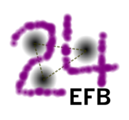Speaker
Description
In our work we have studied ${}^9{\rm Be}$ ground state with non-local $\alpha n$ and $\alpha\alpha$ potentials derived from Cluster Effective Field Theory. The Borromean system provided by the nucleus of ${}^9{\rm Be}$ shows, at low energy ($<\,20\,$MeV), a separation of scales and the dynamics describing the cluster configuration is insensitive to internal dynamics of the $\alpha$ particle. Therefore to describe such cluster nuclei we can use an Effective Field Theory where the degrees of freedom are represented by neutrons and $\alpha$ particles. We study the interaction among alpha and valence neutrons using non-local contact interactions. The potentials extracted from the theory are regularized by a Gaussian cutoff which regulates the short-distance dependence of the interaction. We choose the cutoff regularization, because of its ability to reproduce known features, such as parameters in the effective range expansion, including the scattering length and the effective range. Then, the potential parameters are fitted to reproduce these scattering parameters in the calculated scattering T-matrix. We implemented such non-local potential models in a Non-Symmetrized Hyperspherical Harmonics (NSHH) code in momentum space. The final goal of this project is to use these potentials in the calculation of the photodisintegration of ${}^9{\rm Be}$, a reaction of astrophysical relevance. Work is in progress to insert an effective $\alpha \alpha n$ interaction in the theory, then the prediction of the photodisintegration will be realized with the LIT method.

